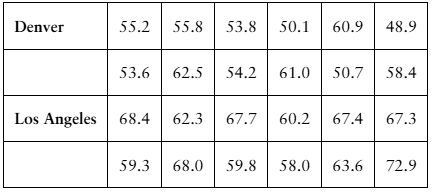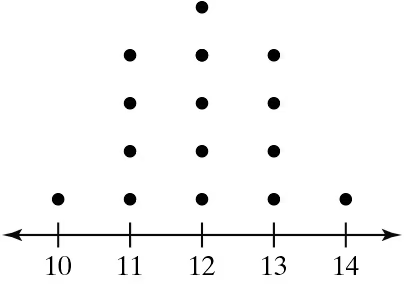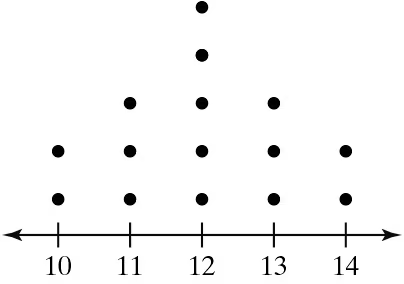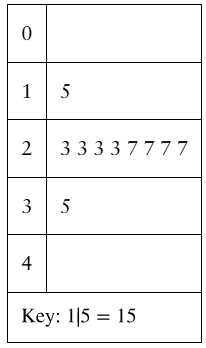 Back
BackProblem 2.4.33
Using the Empirical Rule In Exercises 29–34, use the Empirical Rule.
The speeds for eight vehicles are listed. Using the sample statistics from Exercise 29, determine which of the data entries are unusual. Are any of the data entries very unusual? Explain your reasoning.
70, 78, 62, 71, 65, 76, 82, 64
Problem 2.4.54c
Shifting Data Sample annual salaries (in thousands of dollars) for employees at a company are listed.
40 35 49 53 38 39 40
37 49 34 38 43 47 35
c. Each employee in the sample takes a pay cut of $2000 from their original salary. Find the sample mean and the sample standard deviation for the revised data set.
Problem 2.4.52b
Mean Absolute Deviation Another useful measure of variation for a data set is the mean absolute deviation (MAD). It is calculated by the formula
MAD = Σ |x − x̄| / n.
b. Find the mean absolute deviation of the data set in Exercise 16. Compare your result with the sample standard deviation obtained in Exercise 16.
Problem 2.4.53b
Scaling Data Sample annual salaries (in thousands of dollars) for employees at a company are listed.
42 36 48 51 39 39 42
36 48 33 39 42 45 50
b. Each employee in the sample receives a 5% raise. Find the sample mean and the sample standard deviation for the revised data set.
Problem 2.4.51b
Extending Concepts
Alternative Formula You used SSₓ = Σ(x − x̄)² when calculating variance and standard deviation. An alternative formula that is sometimes more convenient for hand calculations is
SSₓ = Σ x² − (Σ x)² / n.
You can find the sample variance by dividing the sum of squares by n − 1 and the sample standard deviation by finding the square root of the sample variance.
b. Use the alternative formula to calculate the sample standard deviation for the data set in Exercise 15.
Problem 2.4.45
Comparing Variation in Different Data Sets In Exercises 45–50, find the coefficient of variation for each of the two data sets. Then compare the results.
Annual Salaries Sample annual salaries (in thousands of dollars) for entry level architects in Denver, CO, and Los Angeles, CA, are listed.
Problem 2.4.48
Comparing Variation in Different Data Sets In Exercises 45–50, find the coefficient of variation for each of the two data sets. Then compare the results.
Heights and Weights The heights (in inches) and weights (in pounds) of every France national soccer team player that started the 2018 FIFA Men’s World Cup final are listed. (Source: ESPN)
Problem 2.4.21c
Graphical Analysis In Exercises 21–24, you are asked to compare three data sets.
(c) Estimate the sample standard deviations. Then determine how close each of your estimates is by finding the sample standard deviations.
i.
ii.
iii.
Problem 2.4.55a
Pearson’s Index of Skewness The English statistician Karl Pearson (1857–1936) introduced a formula for the skewness of a distribution.
P = 3 (x̄ - median) / s
Most distributions have an index of skewness between -3 and 3. When P > 0, the data are skewed right. When P < 0, the data are skewed left. When P = 0, the data are symmetric. Calculate the coefficient of skewness for each distribution. Describe the shape of each.
a. x̄ = 17, s = 2.3, median = 19
Problem 2.4.55c
Pearson’s Index of Skewness The English statistician Karl Pearson (1857–1936) introduced a formula for the skewness of a distribution.
P = 3 (x̄ - median) / s
Most distributions have an index of skewness between -3 and 3. When P > 0, the data are skewed right. When P < 0, the data are skewed left. When P = 0, the data are symmetric. Calculate the coefficient of skewness for each distribution. Describe the shape of each.
c. x̄ = 9.2, s = 1.8, median = 9.2
Problem 2.4.55e
Pearson’s Index of Skewness The English statistician Karl Pearson (1857–1936) introduced a formula for the skewness of a distribution.
P = 3 (x̄ - median) / s
Most distributions have an index of skewness between -3 and 3. When P > 0, the data are skewed right. When P < 0, the data are skewed left. When P = 0, the data are symmetric. Calculate the coefficient of skewness for each distribution. Describe the shape of each.
e. x̄ = 155, s = 20.0, median = 175
Problem 2.4.23
Graphical Analysis In Exercises 21–24, you are asked to compare three data sets.
(c) Estimate the sample standard deviations. Then determine how close each of your estimates is by finding the sample standard deviations.
i.
ii.
iii.
Problem 2.5.1
Building Basic Skills and Vocabulary
The length of a guest lecturer’s talk represents the third quartile for talks in a guest lecture series. Make an observation about the length of the talk.
Problem 2.5.32
Interpreting Percentiles In Exercises 29–32, use the ogive, which represents the cumulative frequency distribution for quantitative reasoning scores on the Graduate Record Examination in a recent range of years. (Adapted from Educational Testing Service)
What percentile is a score of 170? How should you interpret this?
Problem 2.5.57a
Song Lengths Side-by-side box-and-whisker plots can be used to compare two or more different data sets. Each box-and-whisker plot is drawn on the same number line to compare the data sets more easily. The lengths (in seconds) of songs played at two different concerts are shown.
a. Describe the shape of each distribution. Which concert has less variation in song lengths?
Problem 2.5.57d
Song Lengths Side-by-side box-and-whisker plots can be used to compare two or more different data sets. Each box-and-whisker plot is drawn on the same number line to compare the data sets more easily. The lengths (in seconds) of songs played at two different concerts are shown.
d. Can you determine which concert lasted longer? Explain.
Problem 2.5.60
Modified Box-and-Whisker Plot In Exercises 59–62, (a) identify any outliers and (b) draw a modified box-and-whisker plot that represents the data set. Use asterisks (*) to identify outliers.
75 78 80 75 62 72 74 75 80 95 76 72
Problem 2.5.15b
Drawing a Box-and-Whisker Plot In Exercises 15–18,
(b) draw a box-and-whisker plot that represents the data set.
39 36 30 27 26 24 28 35 39 60 50 41 35 32 51
Problem 2.5.16b
Drawing a Box-and-Whisker Plot In Exercises 15–18,
(b) draw a box-and-whisker plot that represents the data set.
171 176 182 150 178 180 173 170 174 178 181 180
Problem 2.5.17b
Drawing a Box-and-Whisker Plot In Exercises 15–18,
(b) draw a box-and-whisker plot that represents the data set.
4 7 7 5 2 9 7 6 8 5 8 4 1 5 2 8 7 6 6 9
Problem 2.5.6
Building Basic Skills and Vocabulary
Describe the relationship between quartiles and percentiles.
Problem 2.5.8
True or False? In Exercises 7–10, determine whether the statement is true or false. If it is false, rewrite it as a true statement.
The second quartile is the mean of an ordered data set.
Problem 2.5.11a
Using and Interpreting Concepts
Using and Interpreting Concepts Finding Quartiles, Interquartile Range, and Outliers In Exercises 11 and 12,
(a) find the quartiles
56 63 51 60 57 60 60 54 63 59 80 63 60 62 65
Problem 2.5.11b
Using and Interpreting Concepts
Using and Interpreting Concepts Finding Quartiles, Interquartile Range, and Outliers In Exercises 11 and 12,
(b) find the interquartile range
56 63 51 60 57 60 60 54 63 59 80 63 60 62 65
Problem 2.5.11c
Using and Interpreting Concepts
Using and Interpreting Concepts Finding Quartiles, Interquartile Range, and Outliers In Exercises 11 and 12,
(c) identify any outliers.
56 63 51 60 57 60 60 54 63 59 80 63 60 62 65
Problem 2.5.13
Graphical Analysis In Exercises 13 and 14, use the box-and-whisker plot to identify the five-number summary.
Problem 2.5.17a
Drawing a Box-and-Whisker Plot In Exercises 15–18,
(a) find the five-number summary
4 7 7 5 2 9 7 6 8 5 8 4 1 5 2 8 7 6 6 9
Problem 2.5.18a
Drawing a Box-and-Whisker Plot In Exercises 15–18,
(a) find the five-number summary
2 7 1 3 1 2 8 9 9 2 5 4 7 3 7 5 4
2 3 5 9 5 6 3 9 3 4 9 8 8 2 3 9 5
Problem 2.5.35
Finding a Percentile In Exercises 33–36, use the data set, which represents the ages of 30 executives.
43 57 65 47 57 41 56 53 61 54
56 50 66 56 50 61 47 40 50 43
54 41 48 45 28 35 38 43 42 44
Which ages are above the 75th percentile?
Problem 2.5.18b
Drawing a Box-and-Whisker Plot In Exercises 15–18,
(b) draw a box-and-whisker plot that represents the data set.
2 7 1 3 1 2 8 9 9 2 5 4 7 3 7 5 4
2 3 5 9 5 6 3 9 3 4 9 8 8 2 3 9 5










